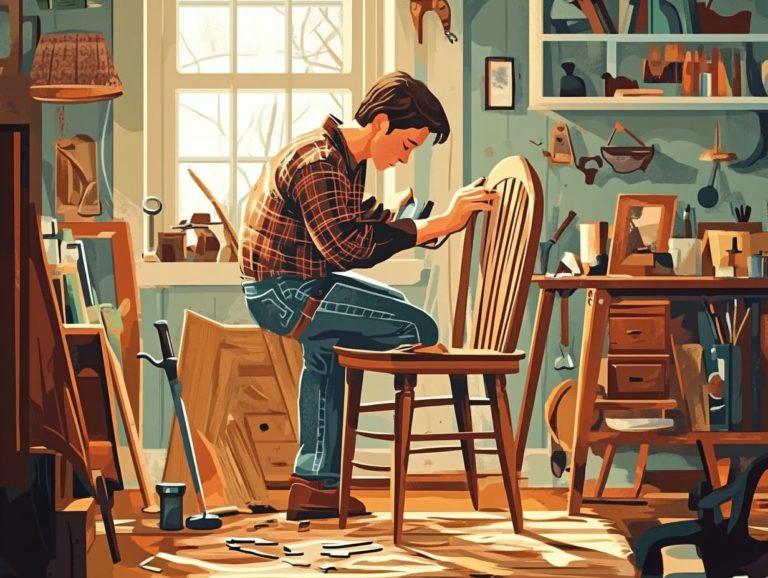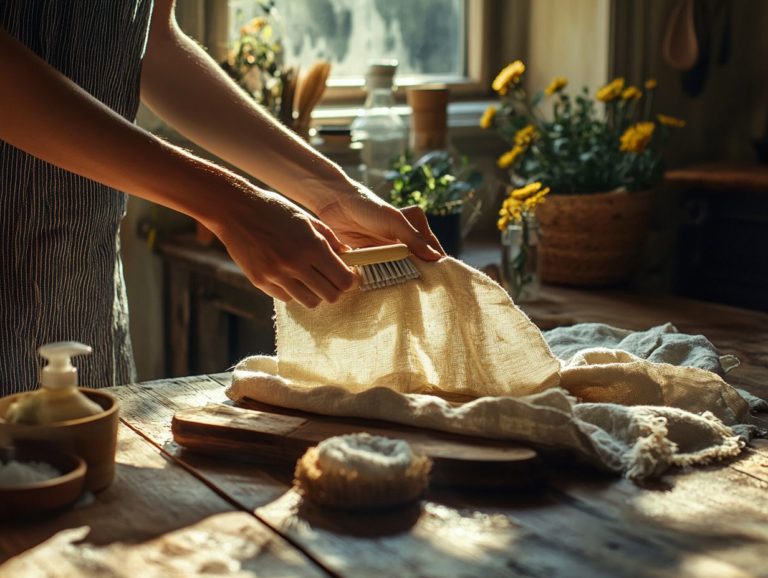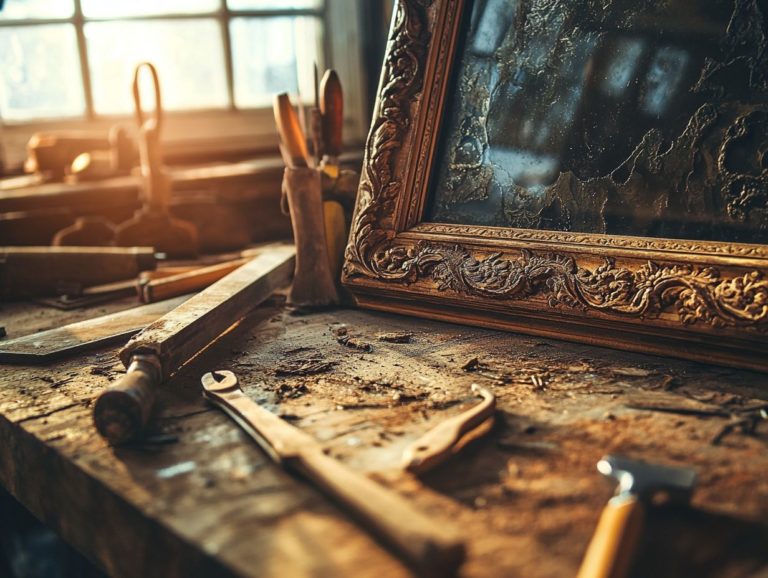Upcycling Vintage Furniture: Ideas and Inspiration
Looking to infuse fresh energy into your home decor? Upcycling vintage furniture is a great way to merge style, creativity, and sustainability seamlessly.
Transform old pieces into standout pieces and introduce vibrant color that resonates with your personality. This guide is brimming with inspiration tailored just for you.
Unearth the art of repurposing furniture for diverse uses, blend styles to cultivate an eclectic vibe, and infuse vintage charm into contemporary spaces. Explore inventive techniques that enhance your home while celebrating the timeless beauty of the past.
Contents
- Key Takeaways:
- 1. Create Unique Treasures from Old Furniture
- 2. Add a Pop of Color with Paint
- 3. Repurposing Furniture for Different Uses
- 4. Mixing and Matching Styles for an Eclectic Look
- 5. Incorporating Vintage Furniture into Modern Decor
- 6. Using Salvaged Materials for DIY Projects
- 7. Creating a Shabby Chic Aesthetic
- 8. Giving New Life to Antique Pieces
- 9. Upcycling Furniture for Outdoor Spaces: Creative Storage Ideas
- 10. Using Vintage Furniture as Statement Pieces
- How to Find and Choose Quality Vintage Furniture
- Creative Ways to Incorporate Vintage Furniture into a Room
- Benefits of Upcycling Furniture
- Staying on Budget When Upcycling Furniture
- Frequently Asked Questions on DIY Projects
- What is upcycling vintage furniture?
- Why should I consider upcycling instead of buying new furniture?
- Where can I find inspiration for upcycling vintage furniture?
- What are some popular ideas for upcycling vintage furniture?
- Do I need any special skills to upcycle vintage furniture?
- Can I upcycle any type of vintage furniture?
Key Takeaways:
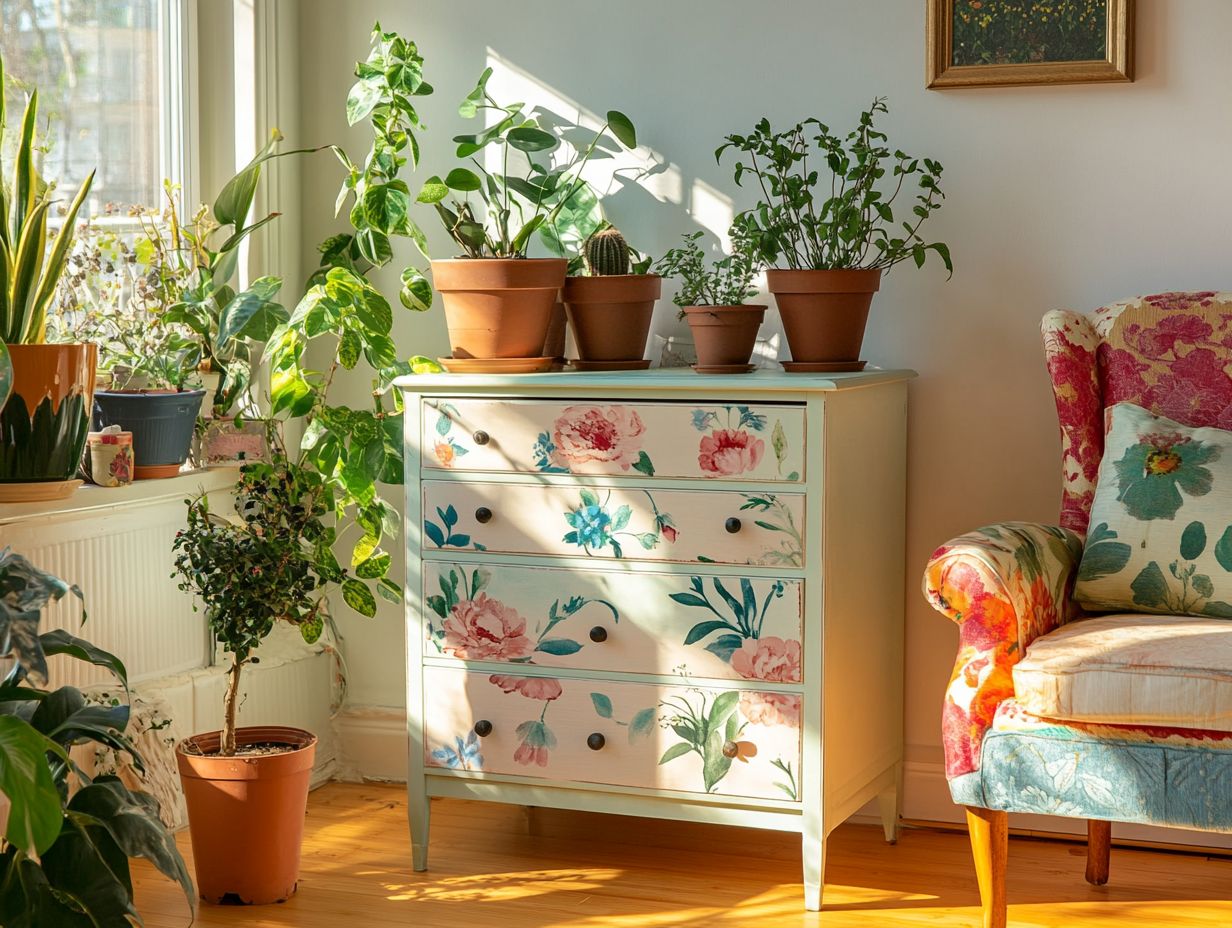
- Transform old furniture into unique pieces to add character to your space.
- Add a pop of color with paint to give new life to vintage furniture.
- Repurpose furniture for different uses, like turning an old dresser into a TV stand.
1. Create Unique Treasures from Old Furniture
Turn your old furniture into unique treasures that breathe new life into items that might otherwise contribute to furniture waste. It offers a canvas to express your creativity while making a positive impact on sustainability through upcycling and DIY projects.
Start with simple techniques, such as applying chalk paint to elevate the look of worn-out chairs or tables, giving them a chic, modern edge. Explore furniture ideas online to find creative approaches, like mixing materials or incorporating vintage hardware for added character.
Designers like Max McMurdo showcase how functional vintage pieces can blend into contemporary interiors. The emotional connection to old items amplifies their allure. By refurbishing cherished family heirlooms or thrifted treasures, you preserve memories and create a conversation between past and present aesthetic sensibilities.
2. Add a Pop of Color with Paint
Adding a pop of color with paint can transform your ordinary furniture into eye-catching statement pieces, infusing your home decor with vibrant personality. Opt for bold accent colors or playful patterns to elevate your furniture makeover.
Among the many techniques at your disposal, chalk paint shines with its matte finish and user-friendly application, making it ideal for achieving rustic or vintage looks. Decorative painting styles, like stenciling or sponge techniques, invite your creativity and offer a unique touch, allowing you to craft intricate designs that reflect your style.
Consider infusing your pieces with bright hues like teal or mustard yellow. Not only will these colors rejuvenate tired surfaces, but they will also enhance the overall aesthetics, breathing life into any room.
By thoughtfully incorporating these vibrant colors and techniques, you can create a decor theme that is both bold and cohesive, showcasing your individuality in every detail. Don’t miss the chance to bring your unique style to life!
3. Repurposing Furniture for Different Uses
Repurposing furniture for different uses is a smart way to design. It maximizes functionality and elevates style. By transforming items into creative storage solutions or innovative decor pieces, you help reduce furniture waste.
This trend highlights the versatility of upcycled furniture, which refers to furniture that has been creatively reused. It promotes a sustainable lifestyle through the joy of DIY upcycling.
Take, for example, an old sideboard. You can reimagine it as a stylish storage unit by giving it a bold coat of paint and adding stylish knobs. This achieves a beautiful blend of aesthetic appeal and practicality.
You can also refurbish an old kitchen island to become a stunning focal point in your living room. Adorn it with decorative items or vibrant plants to enhance its charm.
The furniture industry is currently embracing minimalist designs with multifunctional uses. This aligns perfectly with the trend of rethinking furniture. It enables you to integrate unique finds into your home while making a striking statement, ultimately contributing to a sustainable future.
4. Mixing and Matching Styles for an Eclectic Look
Mixing and matching styles for an eclectic look allows you to create spaces that are personalized and visually stimulating. By combining vintage furniture with modern aesthetics, you reflect your unique tastes.
This home decor approach encourages creativity and customization, leading to inviting interiors. To achieve a cohesive blend, consider color palettes and textures that complement each other.
For instance, pairing bold mid-century pieces with sleek contemporary furnishings creates a balanced look that feels inviting, especially when accented with neutral tones and organic materials.
Adding rugs or artwork helps blend different styles, establishing a unified narrative throughout your space. By strategically placing statement pieces alongside simpler items, you can effortlessly anchor the room.
This results in an environment that is both functional and expressive, perfectly tailored to your lifestyle. What styles do you plan to mix?
5. Incorporating Vintage Furniture into Modern Decor
Incorporating vintage furniture into your modern decor creates a captivating interplay between old and new. It allows you to showcase statement pieces that enhance the overall aesthetic of your space.
This fusion emphasizes the value of vintage decor while also highlighting contemporary furniture trends that embrace historical elements.
By blending the rich textures and warm hues characteristic of vintage design with sleek, minimalist pieces typical of modern decor, you can create a harmonious environment.
For example, pairing a mid-century wooden coffee table with a contemporary leather sofa invites an inviting contrast that naturally draws the eye.
A pop of color from retro accent chairs can beautifully complement a more subdued palette. Vintage finds often serve as functional items and intriguing conversation starters.
They invite your guests to engage in stories of craftsmanship and history, enriching the overall home styling experience. Try mixing your favorite styles today and see the transformation!
6. Using Salvaged Materials for DIY Projects
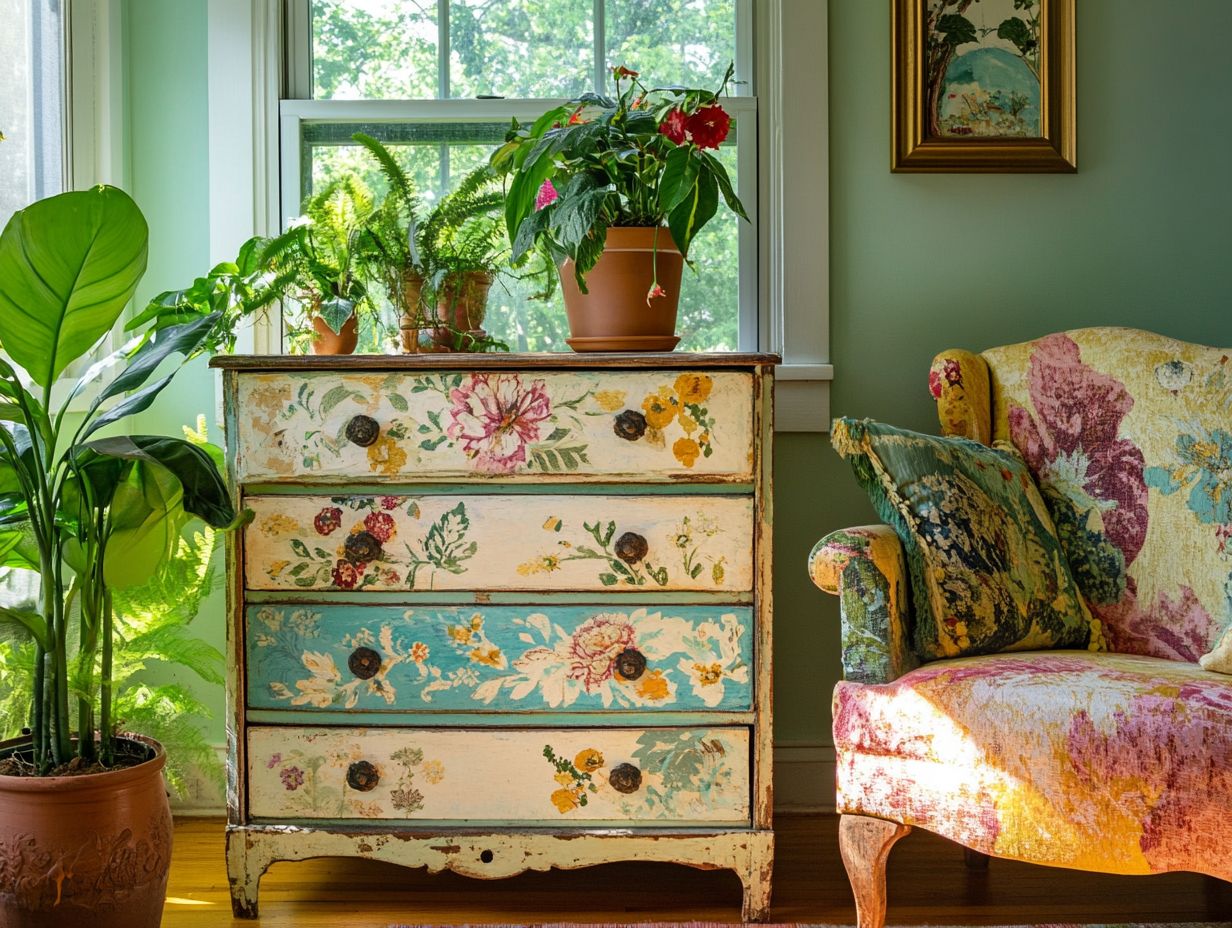
Using salvaged materials for your DIY projects not only champions sustainability but also infuses your creations with unique character and a rich history. Innovative applications of scaffolding and salvaged wood in furniture restoration exemplify this eco-friendly approach to upcycled furniture.
Imagine transforming wood from pallets, reclaimed barn doors, or even old window frames into stunning pieces that tell a story. Local reclamation yards, flea markets, and online marketplaces are treasure troves brimming with potential.
When you source these materials thoughtfully, you reduce waste and craft personalized furniture that aligns perfectly with your aesthetic. Picture chic coffee tables made from old doors and rustic shelving units from reclaimed wood each showcasing the beauty and functionality of restored furniture in your living space.
7. Creating a Shabby Chic Aesthetic
Creating a shabby chic aesthetic requires a thoughtful blend of vintage decor and modern design elements. This combination results in a charming atmosphere that celebrates the allure of imperfection.
This style features furniture makeovers adorned with playful patterns, soft color palettes, and personalized touches that truly reflect your unique taste. Infuse your space with hues like dusty pastels, soft whites, and delicate grays to establish a serene backdrop.
Fabrics such as linen, lace, and floral prints add an inviting softness and comfort, making any area feel welcoming. Incorporating distressed finishes on items like weathered dining tables or elegant, aged armoires adds character while telling a story.
Vintage finds, such as a rustic side table or a charming chandelier, allow you to mix and match effortlessly. This creates a cohesive look that resonates with nostalgia while maintaining a fresh, airy vibe.
8. Giving New Life to Antique Pieces
Revitalizing antique pieces doesn’t just preserve their historical significance; it enhances their beauty and keeps them relevant in contemporary spaces. These heirloom treasures evoke a deep emotional connection while aligning with current furniture trends.
You can use various restoration techniques to achieve this. For instance, refinishing rejuvenates the wood’s surface, restoring its natural luster. Upholstery work breathes new life into antique chairs and sofas, allowing modern fabrics to highlight their classic shapes.
Incorporating contemporary paint options can transform dated furniture, providing a striking contrast that complements today s interiors. It’s essential to maintain the integrity of these cherished items during restoration.
Ensure their character and history remain intact as they adapt to meet the aesthetic demands of modern homes.
9. Upcycling Furniture for Outdoor Spaces: Creative Storage Ideas
Upcycling furniture for your outdoor spaces is a brilliant way to merge functionality with creativity. Transform everyday items into stylish seating or inventive storage solutions that can brave the elements.
By embracing eco-friendly projects, you repurpose materials and elevate the ambiance of your outdoor area. Transform old wooden pallets into charming garden benches or discarded crates into unique planters that add character to your garden!
When selecting materials, think about finishes that endure rain, sun, and fluctuating temperatures. Consider options like marine-grade varnish, a durable coating for outdoor wood, or weather-resistant paint to ensure longevity.
Layering textures and colors can create a cohesive look that harmoniously blends various upcycled elements. These projects not only optimize space but also add a personal touch to your outdoor decor, beautifully reflecting your style while being gentle on the planet.
10. Using Vintage Furniture as Statement Pieces
Using vintage furniture as statement pieces can dramatically transform your room, infusing it with character and charm while serving as captivating focal points in your home styling. These carefully selected items often spark conversation and elevate the overall aesthetic of your space, making them invaluable in contemporary decor.
For example, a mid-century modern coffee table can act as an elegant centerpiece in your living room. A Victorian-era armchair brings a touch of sophistication and invites comfort. Enhance these pieces with accessories like layered textiles. Bold throw pillows and a cozy blanket over the armchair can create an inviting atmosphere.
Unique lighting fixtures, such as a vintage chandelier or a stylish table lamp, can further accentuate these furniture choices, ensuring they stand out beautifully against the backdrop of your curated decor.
How to Find and Choose Quality Vintage Furniture
Finding and selecting quality vintage furniture requires careful judgment and a solid grasp of furniture principles. This knowledge empowers you to spot fantastic pieces that resonate with your aesthetic and endure through the years.
Whether you re on the hunt in thrift stores or browsing online marketplaces, staying attuned to current furniture trends is essential for making informed decisions in your DIY endeavors.
Pay close attention to key elements like materials. Hardwood furniture often indicates durability, while softwoods can reveal age and a certain charming character. Look for signs of craftsmanship, such as dovetail joints and hand-finished details. These features reflect the dedication of the maker. Embrace subtle signs of wear, as they can add depth and personality rather than detract from the overall appeal.
When sourcing these treasures, consider your pricing strategies. A bit of negotiation can lead to fantastic deals. Think about how these vintage pieces will connect with your existing decor, crafting a cohesive yet eclectic style that truly showcases your personality.
What Are Some Common DIY Techniques for Upcycling Furniture?
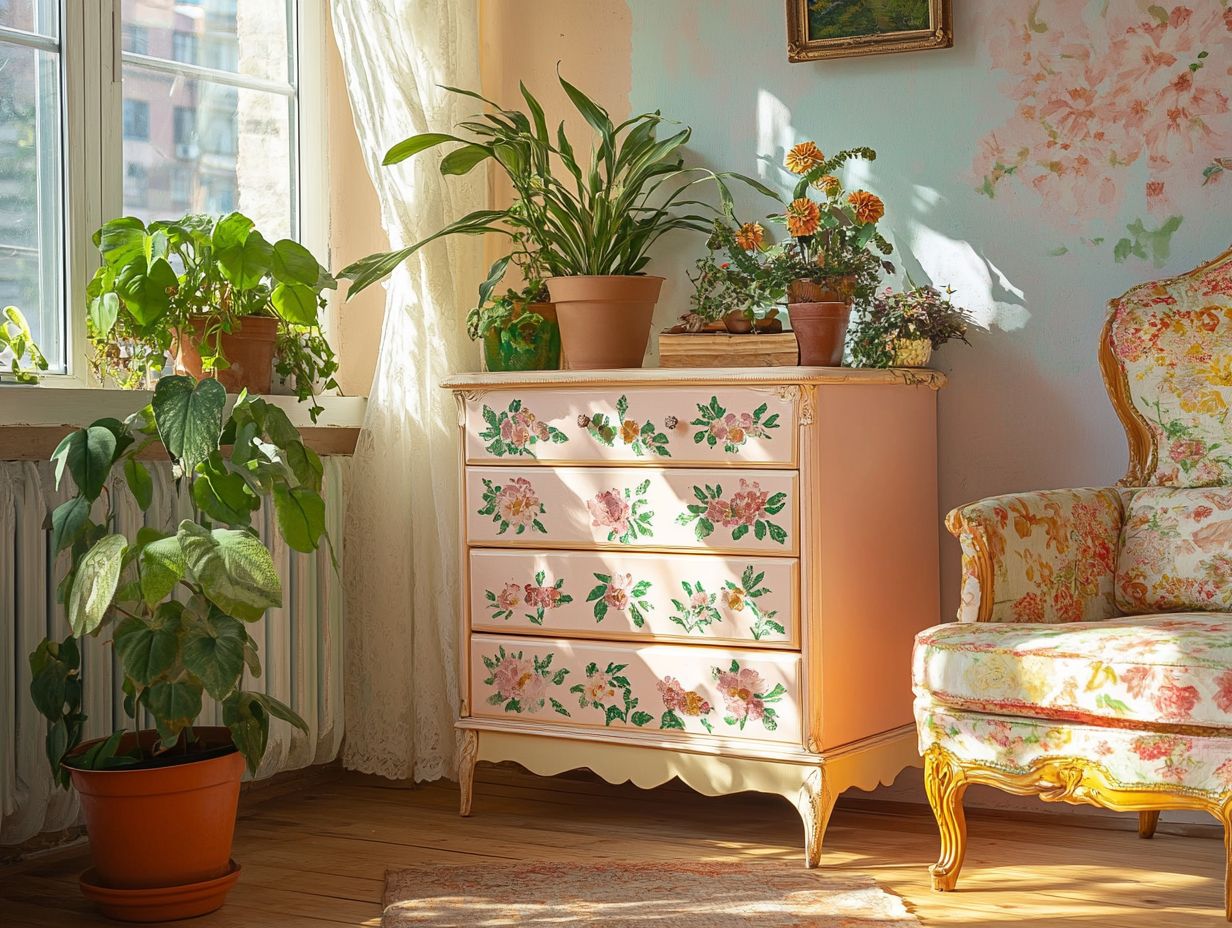
Common DIY techniques for upcycling furniture encompass a range of paint techniques, refinishing methods, and imaginative reimagining. These methods breathe new life into old items and assign them a fresh purpose. They enhance the look of your furniture while helping with restoration and revitalization.
One standout method is decoupage. Adhere decorative paper to surfaces for endless design possibilities. Use a decoupage medium to apply and seal the paper easily. Another effective technique is stenciling, which introduces intricate patterns to any piece in just a few simple steps.
Chalk paint is gaining popularity, as it demands minimal surface preparation and delivers a matte finish that can be effortlessly distressed for that coveted vintage look. By following straightforward guides like preparing surfaces meticulously and selecting the right brushes even beginners can achieve remarkable transformations, turning a weary chair into a bold statement piece or an old table into a chic focal point.
How Can Vintage Furniture Add Character to a Space?
Vintage furniture has the remarkable ability to infuse your space with character. It offers a unique style and rich history that modern pieces often lack. By integrating these distinctive items into your home decor, you enhance the overall aesthetics, cultivating an atmosphere brimming with storytelling and individuality.
For many, the magic lies in blending vintage pieces with contemporary designs, creating a striking contrast that adds warmth and authenticity to various environments. Picture a sleek, minimalist living room brought to life by an antique oak coffee table or an industrial-chic kitchen softened by retro dining chairs. These carefully selected vintage accents do more than serve a functional purpose; they evoke nostalgia and foster a deeper connection to the past, sparking conversation and reflection.
In bedrooms adorned with heirloom dressers or cozy reading nooks featuring vintage armchairs, the unique stories behind each piece can transform the ambiance, making any space feel truly special and inviting.
Creative Ways to Incorporate Vintage Furniture into a Room
Incorporating vintage furniture into your space can be a delightful endeavor. This allows you to blend timeless pieces with modern styles, making a striking impression.
Imagine mixing a chic vintage armchair with a sleek, contemporary dining table. This combination creates an eclectic yet harmonious atmosphere that speaks volumes. Consider using an antique trunk as a coffee table; it adds history and offers practical storage solutions.
To pull the look together, accessorize with modern throw pillows that boast bold patterns or colors. These can be perfectly juxtaposed with a vintage rug that infuses warmth and character. This fusion of styles captivates the eye and encourages your guests to appreciate the curated blend of eras you’ve thoughtfully created.
Benefits of Upcycling Furniture
The benefits of upcycling furniture extend beyond aesthetics. Upcycling invites you into a world of eco-friendly projects that minimize waste and spark creativity while breathing new life into pieces that deserve a second chance.
This practice champions a sustainable future and weaves emotional narratives through the stories attached to each item. As you reimagine and repurpose old furniture, you join a movement that helps save an estimated 12 million tons of furniture from landfills each year, according to the Environmental Protection Agency.
Transforming discarded pieces allows you to create unique home decor that resonates with your personal history. This fosters a deeper emotional connection with your surroundings through your furniture restoration efforts.
Experts in sustainable design stress that these creative pursuits curb material consumption and save you money. A well-executed upcycling project can cost up to 50% less than purchasing new items. Each refurbishment ignites a sense of pride, allowing you to embrace your role in championing a healthier planet while enjoying the charm of a one-of-a-kind piece.
Staying on Budget When Upcycling Furniture
Staying on budget while upcycling furniture is achievable when you embrace smart shopping strategies and cultivate a creative mindset. This approach lets you transform thrift store gems into stunning home decor without straining your finances.
Start by scouring local garage sales, flea markets, and online classified ads. You’ll often discover inexpensive items just waiting for your artistic touch. Leveraging tools you already own can dramatically reduce costs; a simple paintbrush or staple gun can do wonders without fancy equipment.
Meticulous planning is key. Measure your spaces before purchasing materials and sketch your designs to avoid unnecessary expenses. Look for inspiration in successful upcycling endeavors, such as turning an old ladder into a rustic bookshelf or repurposing discarded pallets into unique outdoor furniture. These ideas help you save money while fueling your creativity and promoting sustainability.
Frequently Asked Questions on DIY Projects
What is upcycling vintage furniture?
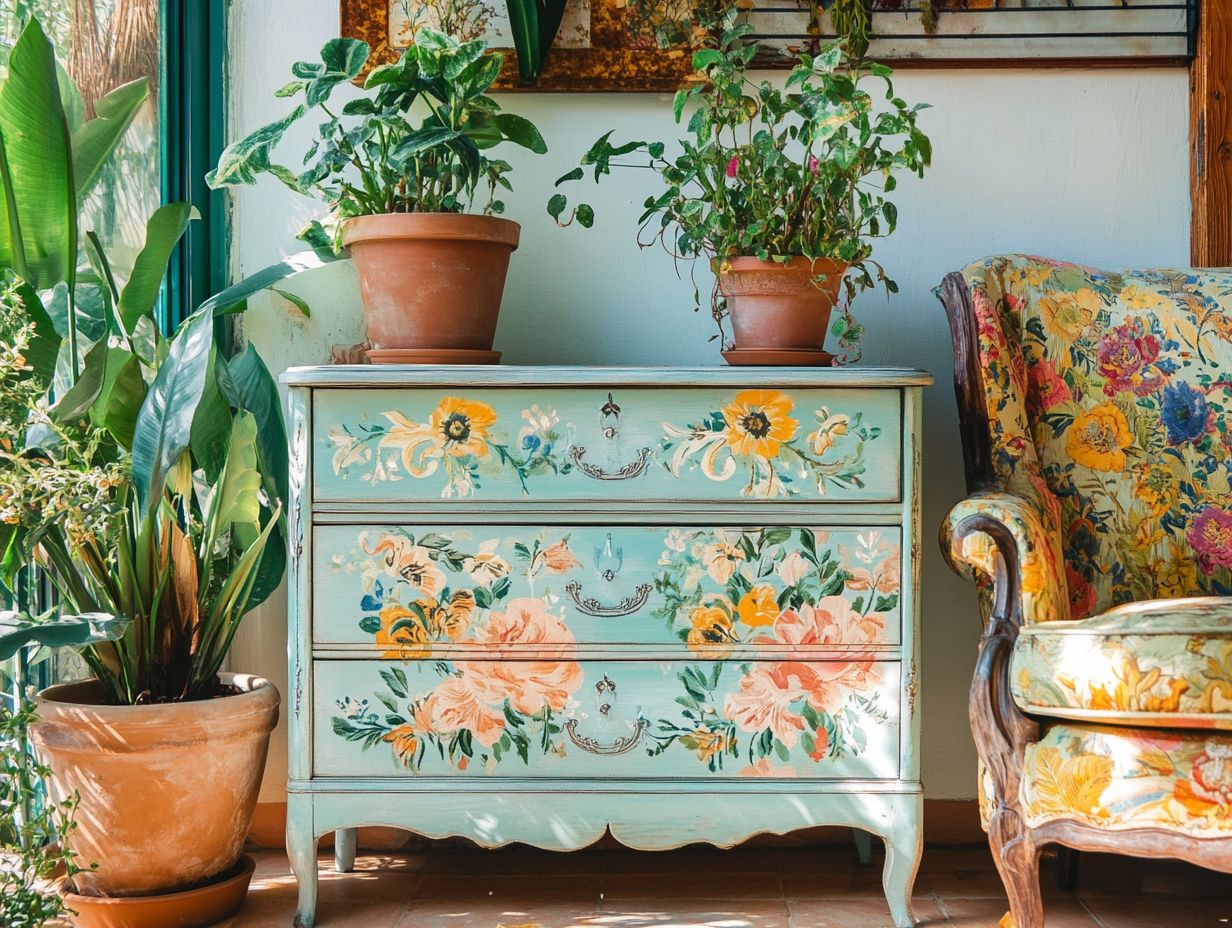
Upcycling vintage furniture means transforming old or used furniture into something new and improved. This can include repainting, reupholstering, and adding unique touches to give the piece a new life.
Why should I consider upcycling instead of buying new furniture?
Upcycling vintage furniture is a sustainable and eco-friendly option. It allows you to create one-of-a-kind pieces that reflect your personal style and taste while saving you money compared to buying new furniture.
Start your upcycling journey today and transform your space!
Where can I find inspiration for upcycling vintage furniture?
Looking for fresh ideas? Check out Pinterest and Instagram for stunning upcycling projects. Flea markets and secondhand stores are treasure troves waiting for your creativity!
What are some popular ideas for upcycling vintage furniture?
Want to transform your furniture? Use stencils for unique patterns or turn an old dresser into a chic kitchen island! You can also try decoupage, a craft technique that involves decorating by gluing colored paper cutouts onto your furniture.
Do I need any special skills to upcycle vintage furniture?
No, you don t need to be a DIY expert! Exciting projects await you, and you only need basic tools to get started. If you’re unsure about certain techniques, watching tutorials or taking a class can be really helpful.
Can I upcycle any type of vintage furniture?
Absolutely! You can give new life to almost any vintage furniture, including chairs, tables, and dressers. Just remember, some materials may be trickier to work with, so choose a project that matches your skill level and comfort.

